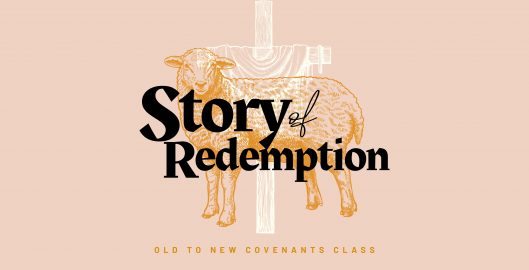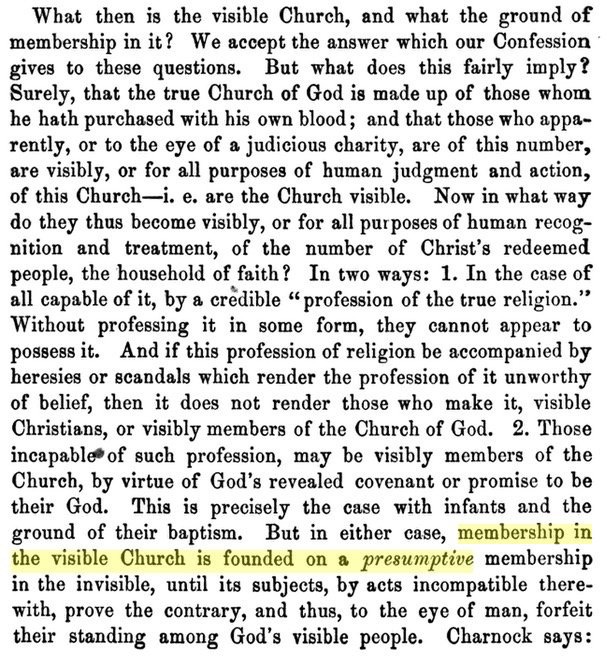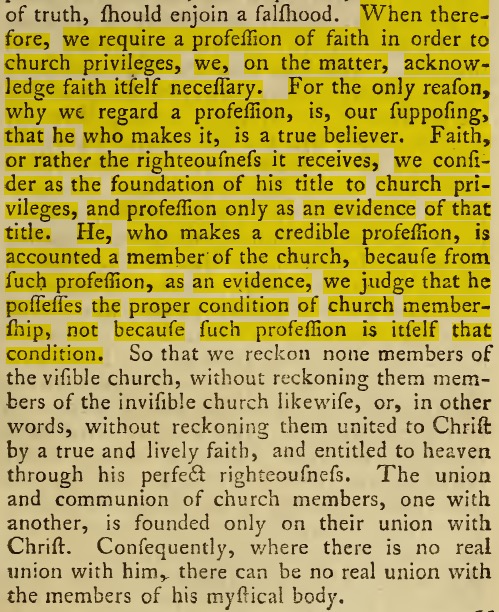Video
The Story of Redemption (Sunday School Class)
The Story of Redemption is an introductory level class on 1689 Federalism taught by Brandon Adams. It is appropriate for a broad evangelical audience who has never studied the covenants before.
[Post will be updated as more classes become available]PDF Handouts (feel free to copy, edit, and re-use in whatever format you want):
- The Garden of Eden
- The New Covenant in Christ
- The Noahic Covenant of Common Preservation
- The Abrahamic Covenant of Circumcision
- The Old (Mosaic) Covenant
- Fulfillment of the First Abrahamic Promise
- The Davidic Covenant
- Exile
- Return from Exile (Prophecy)
- The New Covenant (Fulfillment of Types and Shadows) Part 1
- The New Covenant (Fulfillment of Types and Shadows) Part 2
Semper Reformanda 2023: Covenant and Kingdom
On 24, Oct 2023 | In Audio, James Renihan, Pascal Denault, Resources, Samuel Renihan, Video | By Brandon Adams
Grace Family Baptist Church in Houston, TX recently held their annual Semper Reformanda conference. This year was on Covenant and Kingdom: A Study in Reformed Baptist Covenant Theology featuring James Renihan, Sam Renihan, and Pascal Denault.
The recordings are now available online (both audio and video):
https://web.sermonaudio.com/broadcasters/gracefamilybaptist/series/183063

1) The Great DivideDr. James M. Renihan 100+ Conference


2) The Mystery of ChristDr. Samuel Renihan 100+ Conference


3) Distinctives Between Particular Baptist and Paedobaptist FederalismPascal Denault 100+ Conference


4) Baptist Covenant Theology vs. DispensationalismPascal Denault 100+ Conference


5) Kingdom of Creation: Covenant of Works and Noahic CovenantDr. Samuel Renihan Conference


7) Kingdom of Israel: Abrahamic, Mosaic, and Davidic CovenantsDr. Samuel Renihan Conference


8) Kingdom of Christ: Covenants of Redemption and Grace, and Eschatalogical Nature Dr. Samuel Renihan Conference

Two-Tier Typology & OT Salvation (Response to Christ the Center)
On 15, Jun 2022 | In Audio, Richard Barcellos, Samuel Renihan, Video | By Brandon Adams
Reformed Forum recently engaged with 1689 Federalism in CTC #736 John Owen, Jeremiah 31, and the Relationship between the Old and New Covenants. We are thankful for their interest in the topic and for the precision they bring to the discussion. Dr. Sam Renihan and Dr. Richard Barcellos joined Brandon Adams to respond to the episode. Our discussion is available on YouTube and as an mp3 file – both in the full (2 hour) and abridged (1 hour) versions. Some supplemental material and links to resources are at the end of this post.
MP3
- MP3: Two-Tier Typology & OT Salvation [1689 Federalism]
- MP3: Two-Tier Typology & OT Salvation (Abridged) [1689 Federalism]
- Podcast RSS Feed (The host may not like this, so let me know if it stops working. See here for instructions to manually add this feed to your podcast player. You need to copy the URL and add it.)
Chapters
- 0:00:00 Introduction
- 0:06:24 Overview of 1689F view of Old Covenant
- 0:07:24 Perfect Obedience vs Outward Obedience
- 0:14:14 Subservient Covenant
- 0:17:22 Objection to Outward Obedience
- 0:26:47 Exile
- 0:32:01 God’s Longsuffering Towards Israel
- 0:33:31 First-tier Function of the Sacrificial System
- 0:44:27 Are All Types Symbols?
- 0:48:16 Salvation of NT Saints
- 0:53:18 Salvation of OT Saints
- 0:58:01 Salvation by the Word in the OT
- 1:04:22 Relationships of Types to the Promise
- 1:07:48 Prophets Looking for Christ; Did all elect fully understand?
- 1:14:36 WCF/2LBCF 8.6
- 1:25:06 Substance of a Covenant: Old v New
- 1:28:39 Did the Old Covenant Promise Regeneration?
- 1:30:09 Were OT Types Bare Forms? First-Tier Function
- 1:31:27 Jer 31: Historia or Ordo?
- 1:34:18 Retroactive New Covenant
- 1:39:05 Historical Theology: Subservient Covenant Quotes
- 1:48:42 Affirm or Deny: Did Sacrifices Remit Outward Sins?
- 1:50:01 Philip Cary
- 1:50:46 Subservient Cov view is Key to Resolving the Debate
- 1:52:54 Vos’ Triangle
Show Notes
- Thomas Goodwin on Old Covenant condition as outward obedience, contra the condition of the Covenant of Works as perfect, perpetual, entire obedience (contrary to the OPC Report on Republication’s claim that the subservient covenant view saw the condition of the Old Covenant as the same as that of the Covenant of Works)
- From Shadow to Substance: The Federal Theology of the English Particular Baptists (1642-1704) Sam Renihan’s dissertation on the subservient covenant tradition, particularly the Particular Baptist branch
- The Mystery of Christ, His Covenant, and His Kingdom Sam Renihan
- The Family Tree of Reformed Biblical Theology: Vos and Owen Richard Barcellos’ dissertation
- 1689Federalism.com
John Cameron
The Sacrifices, Sacraments, and Ceremonies of the Ancients had their carnal use, over and besides the spiritual signification… So Circumcision, primarily, did separate between the seed of Abraham and the rest of the Nations; it did seal unto them the earthly promise: secondarily, it did signify out sanctification. In like manner the Passover, primarily, the passing over of the destroying Angel; secondarily, Christ: so also the sacrifices, and the cleansings, they represented, primarily, a certain carnal holiness: secondarily, they figured out Christ, and the benefits of the New Covenant.[1]Cameron, Three-fold Covenant of God, 399-400.
Thomas Goodwin
There Goodwin asserts that the Mosaic covenant “was Fœdus Subserviens to the Gospel, (as Learned Cameron calls it)” and “was truly the promulgation of the covenant of nature made with Adam.”
Goodwin, Works, V:330.
Following Cameron’s two-tiered typology, Goodwin called the Mosaic covenant an “outward covenant with the Jews” whose ordinances “besides their spiritual use in typifying things Heavenly to Spiritual Believers then, they had an outward carnal use to the whole Nation.” The forgiveness provided by the sacrificial system was “a Forgiveness of reprieval, not to be destroyed for their sin…and so had a Sanctification and a Justification which were not really such, that is, not of the heart and conscience.”
Goodwin, Works, V:331-332. Emphasis original.
John Brinsley
Quest. But how are those sacrifices said to make an Atonement for the people, or to Expiate them? for so the Hebrew word is there most properly rendered, importing a freeing and delivering one from the Guilt and punishment of sin. Now how are those sacrifices said to have done this?
A. For answer to this, we must take notice that in those sins committed under the Law there was a twofold guilt; A Ceremonial and a Moral guilt; or an External and an Eternal guilt. An External or Temporal guilt, a guilt before men, binding the offenders over unto temporal punishment. An Eternal or Spiritual guilt before God, binding them over unto Eternal condemnation. Now as for the former of these, that External or Ceremonial guilt, that was expiated and taken away by performing that which was legally required in the way of a Ceremonial satisfaction. Hereby the people offending was acquitted before men, in foro Externo, and freed from Temporal guilt and punishment, by virtue of that Sacrifice, or rather God’s Ordinance and Institution concerning it. But for the latter, that Eternal and Moral guilt, that was expiated and taken away by those Sacrifices only Typically and Sacramentally: viz. as they represented and shadowed out the true Expiatory Sacrifice of Jesus Christ. And thus are those Sacrifices said to have Expiated the people. It is a Sacramental phrase and manner of speech, wherein that which is the proper effect of the thing signified, is attributed to the sign. Even as the Sacramental water in Baptism is said to wash away sins, Act. 22.16. Thus did the blood of these Sacrifices expiate the sins of the people, by representing the Expiation of Christ, that Satisfaction whereby his people are freed from eternal guilt.
John Brinsley, MESITHS, Or, The One and Onely Mediatour Betwixt God and Men, the Man Christ Jesus (London: Thomas Maxey, 1651), 101-102.
As for those Sacrifices, they extended only to a Ceremonial and Temporal Expiation; and that only of some sins. But the Sacrifice of Christ extends to a real, Eternal Expiation; and that of all sins. So Paul delivers it in his Sermon at Antioch, Act. 13.39. By him all that believe are justified from all things, from which ye could not be justified by the Law of Moses. By the Law of Moses, by those Legal Sacrifices therein prescribed, none could be justified before God for any sins. So much we may learn from this our Apostle, Heb. 10.1. The law can never by those sacrifices, which they offered year by year, make the comers thereunto perfect. That is, as touching the Conscience, as the same pen expounds it, chap. 9.9. They could not in and by themselves, as separated from their spiritual significations, sanctify or purify the Conscience; they being Corporal, and that Spiritual. Neither could they give an absolution in foro conscientiae, they could not give any assurance to the Conscience that sin was pardoned, and reconciliation obtained with God. In reference hereunto the Apostle tells us ver. 4. of that 10th chapter, that It is not possible that the blood of Bulls and of Goats should take away sin: Take away the Eternal guilt of it. And as for the External and Temporal, it extended (as I said) only to some kinds of sin.
Brinsley, MESITHS, 102-103.
John Owen
All the Levitical Services and Ordinances were in themselves carnal, and had carnal ends assigned unto them, and had only an obscure representation of things spiritual and eternal.
Owen, A Continuation of the Exposition, 375.
There were some lines and shadows, to represent the body, but the body itself was not there. There was something above them and beyond them, which they reached not unto.
Owen, A Continuation of the Exposition, 204.
Philip Cary
We do indeed acknowledge the subserviency of the law to Christ, and the covenant of grace…But it does not therefore follow, that the law is a covenant of gospel-grace…The law is not the gospel, nor the gospel the law. And therefore though the one of them is plainly subservient to the other, yet they ought not to be mixed, blended, or confounded the one with the other, as if they were but one and the same covenant, and no difference to be made between them; only in respect of the different degrees of the discovery of gospel grace, as has been suggested… A subserviency in any thing to promote the ends of something else, does not make it to be the thing itself; the ends whereof are promoted thereby.
Philip Cary, A Solemn Call Unto all that would be owned as Christ’s Faithful Witnesses, speedily, and seriously, to attend unto the Primitive Purity of the Gospel Doctrine and Worship: Or, a Discourse concerning Baptism (London: John Harris, 1690), 167.
Podcast: Theocast Intro to Covenant Theology
The Theocast podcast has put together a helpful 5-part introduction to covenant theology from a 1689 Federalism perspective. This truly is an introduction to covenant theology for those who are not familiar with it (i.e. not just an introduction to baptist distinctives).
Introduction to Covenant Theology (website)
Introduction to Covenant Theology (YouTube)
[Editor’s note: I have only listened to these 5 episodes and am otherwise unfamiliar with the podcast]Former Presbyterian Discusses 1689 Federalism vs Westminster (Robert Truelove)
Former Presbyterian pastor Robert Truelove gave an overview of 1689 Federalism compared to Westminster Federalism on Facebook Live (26:48).
(You can also listen to an older podcast episode of the Confessing Baptist where Truelove discusses Taking a Church from Paedobaptism to Credobaptism.![]()
![]()
![]()
Baptist Covenant Theology (Stan Reeves)
In 2014, Stan Reeves did a bible study series at Grace Heritage Church on Baptist Covenant Theology. The material can be found at http://graceheritage.org/resources/bct/. Files include audio, video, PPT, and PDF.
Note: Reeves argues that the dichotomous nature of the Abrahamic Covenant refers to the fact that, according to Gal 4:21-31, Gen 15 and Gen 17 are two different covenants, one unconditional, the other conditional. This is not quite accurate. A better way to understand the duality of the Abrahamic Covenant is to see that God made two promises to Abraham: that he would have numerous offspring possess the land of Canaan, and that he would be the father of the Messiah. From these two promises flow two covenants (Old and New). Or, alternatively, Coxe argued that the promise made to Abraham about the Messiah was the Covenant of Grace and was merely revealed within the Abrahamic Covenant of Circumcision, which was about the numerous physical seed and land of Canaan (which he argues developed into the Mosaic Covenant). But Coxe did not explain the duality in terms of Gen 15 & 17 (note that 15 is all about the physical seed’s journey to Egypt and then into Canaan).
Note: In his lecture on New Covenant Theology, Reeves argues that the New Testament church is a continuation of the Old Testament people of God. He compares it to a caterpillar growing into a butterfly. This is a carry-over from the 20th century Reformed Baptist covenant view and is not in line with 1689 Federalism, which sees Israel according to the flesh as a type of Israel according to the Spirit.
These resources are collected from our Bible study series on confessional Baptist covenant theology. This is a study of the way the Bible unfolds the structure of God’s redemptive plan for His people.
Covenant theology claims that God has unfolded his redemptive plan through a covenant structure with an overall gracious purpose for his people expressed in the covenant of grace.
Baptist covenant theology claims that this structure is not only consistent with an understanding of the church as a regenerate community but that it supports that understanding.
Confessional Baptist covenant theology puts us on notice that we are not doing theology apart from listening to our elders in the faith. These truths are not new; they find clear expression in the Second London Baptist Confession of 1689.
The perspective taught here is sometimes referred to as 1689 Federalism.
Introduction Audio Video Overheads no handout The Covenant of Works Audio Video Overheads Handout The Abrahamic Covenant Audio Video Overheads Handout The Mosaic Covenant Audio Video Overheads Handout The New Covenant Audio Video Overheads Handout The Nature of the Church* Audio Video Overheads Handout Responding to Dispensationalism Audio Video Overheads Handout Responding to New Covenant Theology Audio Video Overheads Handout *Special session on subjects of baptism Audio talk was cut off at 1:18:40 — actual talk was much longer
Nuestro Federalismo
On 12, Dec 2016 | In Video | By Brandon Adams
From Federalismo 1689 espanol on Facebook:
#Estudiosbíblicos | our federalism (1689) #Youtube
Series of classes on the theology of the covenant Baptist, called federalism. An explanation for the development of the divine covenants through the entire bible. A total of 13 lessons.
Lesson 1: Introduction.
Lesson 2: what is a covenant?
Lesson 3: our hermeneutics.
Lesson 4: the covenant of redemption.
Lesson 5: the covenant of works (Part 1).
Lesson 6: the covenant of works (Part 2).
Lesson 7: the covenant of grace.
Lesson 8: the covenant adánico and noéico.
Lesson 9: the covenant Abraham (Part 1).
Lesson 10: the covenant Abraham (Part 2).
Lesson 11: the covenants and davídico mosaic.
Lesson 12: the new covenant.
Lesson 13: applications of our federal theology.
– explained by Pastor Eduardo Flores.
—
Link Youtube playlist: https://www.youtube.com/playlist?list=PLv3ub3R4oYtNz_p22s6QSGCxQQ2rFpXEH
—
#Federalismo1689 #class #videoclases #teologíadelpacto #pactosdivinos![]()
![]()
![]()
NCT, Westminster, & Dispensationalism Videos now w/ Portuguese Subtitles
The following videos are now available with Portuguese subtitles (click the “cc” button in the bottom right) thanks to Daniel Pompermayer! http://batista1689.com/
¿Por Qué Soy Bautista Reformado? (Video)
Pastor Eduardo Flores of Iglesia Bautista Reformado in Costa Rica has a series called “Why Am I A Reformed Baptist?” in Spanish. The 12th sermon in the series explains 1689 Federalism in contrast to Westminster Federalism and Dispensationalism. I am told that in previous lectures there is “a good section on history of the reformed baptists covering Benjamin Keach, Knollys, Nehemiah Coxe, and Hercules Collins, and a good section on Confessionalism. Pastor Eduardo Flores demonstrates familiarity with primary English sources by citing baptist scholars such as Jim Renihan.”
H/T 1689reformedbaptist:
Un bueno serie de predicaciones explicado las creencias distinctivos de bautistas reformadas como el confesionalismo y el federalismo. Las predicaciones son por Pastor Eduardo Flores de la Iglesia Bautista Reformado en Costa Rica:
La predicación acerca del federalismo Bautista reformada (número doce) toma el punto de vista del federalismo 1689 en vez del federalismo presbiteriano de uno pacto de gracia por medio de varios administraciones y también compare el federalismo 1689 con el dispensacionalismo y el federalismo presbiteriano:





